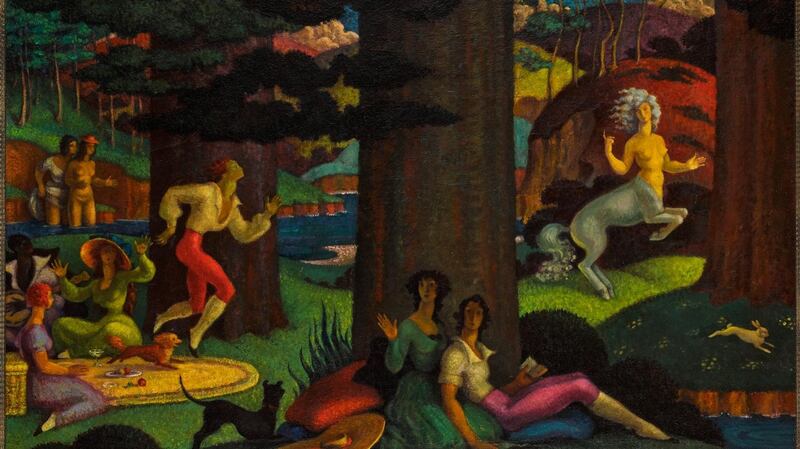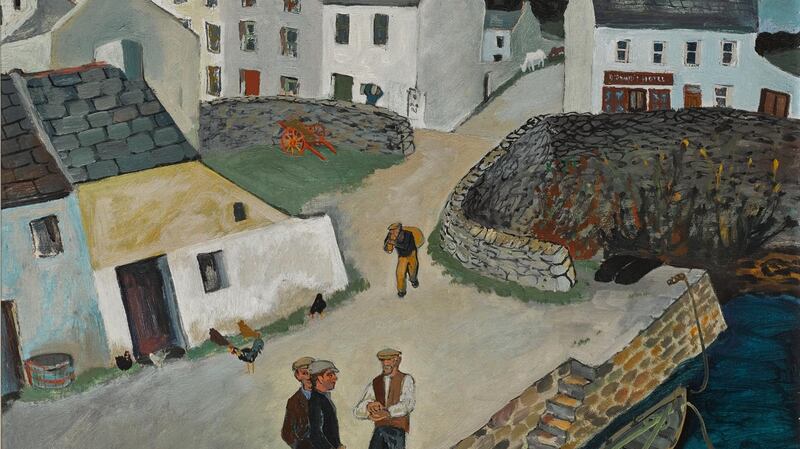In 1992 a Pittsburgh couple, Joseph and Brenda Calihan, wandered into a saleroom during a visit to Dublin. They were enchanted by what they saw – and spent the next decade buying Irish paintings.
“A superb distillation of Irish art across a 100-year period,” is Sotheby’s verdict on the 16 artworks which will lead its Irish Art sale in London in September. The Calihan Collection includes works by Jack B Yeats, Paul Henry, Gerard Dillon and John Luke, and carries a combined estimate in the region of €1.6 million.
“It’s a very focussed, very thoughtful collection,” says Charlie Minter, Sotheby’s head of Irish art. Mr Calihan is a fourth-generation entrepreneur – his grandfather founded Mansmann’s department store in Pittsburgh in 1888 – and there is some Irish heritage in the family.
The couple worked closely with an agent, Maggy Williams. “It was a long process of spotting works, then deciding carefully: is this the type of work we want to go for? Is it a fantastic example by the artist? Maggy would prepare a lot of material for them, and then Joseph and Brenda would spend a lot of time themselves deciding what to do. It was a great partnership, and the result is the collection we have now.”
The most expensive painting in the collection is Jack B Yeats's Sunday Evening in September (St Stephen's Green), which has a guide price of €350,000-€580,000. Painted in 1949, it uses iridescent blues, greens and yellows to portray a young couple strolling through the park at twilight.
“Yeats is the hero of Irish art just now, and this is a wonderful example by him,” Minter says. “It’s a small painting – nine inches by 14 inches – but it’s a very strong visual image. It’s got an absolutely exquisite surface, with beautiful impasto, and it’s in really lovely condition.”
Another small but perfectly-formed work in the sale is John Luke's Pax (€93,000-€140,000). One of 12 lyrical, jewel-like paintings known as the Armagh series, it was painted while Luke was living at Knappagh Farm in Co Armagh, where he went to escape from the devastating German air raids on Belfast during the second World War.
Luke’s working-class background – as a teenager he worked as a riveter in a shipyard, then as a fibre cutter in a linen mill – led him to prize the technical aspects of painting. He started to paint when he took evening classes; later winning a scholarship to the Slade School of Fine Art in London. For the Armagh series Luke used the painstaking medium of tempera, a mixture of ground colour pigments and egg yolk which is time-consuming to apply, but produces brilliant, long-lasting colour.
In a letter to his friend, the poet and critic John Hewitt, Luke wrote: “Most people are by outlook and certainly by training literary minded. There’s nothing wrong with this, but they tend to overlook and even despise manual work, and as Renoir wrote on painting, ‘It is primarily a manual metier’.”
Luke wasn't a prolific painter – he worked on one painting for up to a year at a time – so his works rarely come up for auction. Another painting from the Armagh series, Northern Rhythm, was sold at Sotheby's last year for €215,000. "It was the first Luke of that quality which had come up for auction," says Minter, "and it was great to see how people reacted.
It's an extraordinary image, eccentric and very individual
“In the end, it was bought by somebody who hadn’t even come across Luke but was just captivated by the image and this is another picture which can do that. You don’t necessarily have to follow Irish art to be struck by a beautiful picture like this, and we’ll definitely hope to get lots of international interest.”

Museum quality
If Pax presents an Ireland of peaceful country pursuits, Beatrice Campbell's The Intruder (€46,000-€70,000) conjures up something altogether more feverish. It depicts a wooded landscape where a picnic has been interrupted by the arrival of a female centaur; she beckons a young man, who, as the artist herself put it, "is leaping forward madly to follow her".
Campbell, born into the Elvery family which owned the sports shop on Dublin's Wicklow Street and the mother of the Irish Times columnist Quidnunc, was a sculptor and stained-glass artist as well as a painter. She was a pupil and friend of William Orpen.
“It’s an extraordinary image, eccentric and very individual, but I think a pretty important work,” Minter says. “She does appear at auction, but rarely do you see a work of this quality. It has been on loan at the National Gallery of Ireland and it’s really a museum-quality piece.”

The Calihan Collection also includes Gerard Dillon's The Lobster Pots, Roundstone (€70,000-€93,000). "This was a joyful time in Dillon's life, he had been given the use of a cottage in Roundstone for a year and you get that feeling when you look at the painting." Mischievously, Dillon has included himself in the image; though half-hidden behind another male figure, he is looking directly at the viewer.
Dillon's The Haymakers (€35,000-€58,000) is also in the sale, as are Richard Thomas Moynan's Ball in the Cap (€115,000-€150,000), Paul Henry's Killary Bay (€57,000-€80,000), Daniel Maclise's The Ballad Seller (€35,000-€58,000) and two further works by Yeats, The Circus (€200,000-€350,000) and Early Sunshine (€140,000-€205,000).
“Having handled many of these exceptional paintings in the 1990s, we are thrilled to have been given the opportunity to present them again to a new generation of collectors,” says Arabella Bishop, head of Sotheby’s Ireland. “This year marks our 40th anniversary in Dublin and we feel privileged to be commemorating that special moment in our history with an exhibition of works celebrating the very best of Irish art.”
The paintings from the Calihan Collection will be on public view at the Royal Hibernian Academy, Dublin, August 30th-September 1st. The sale is in London on September 11th.











